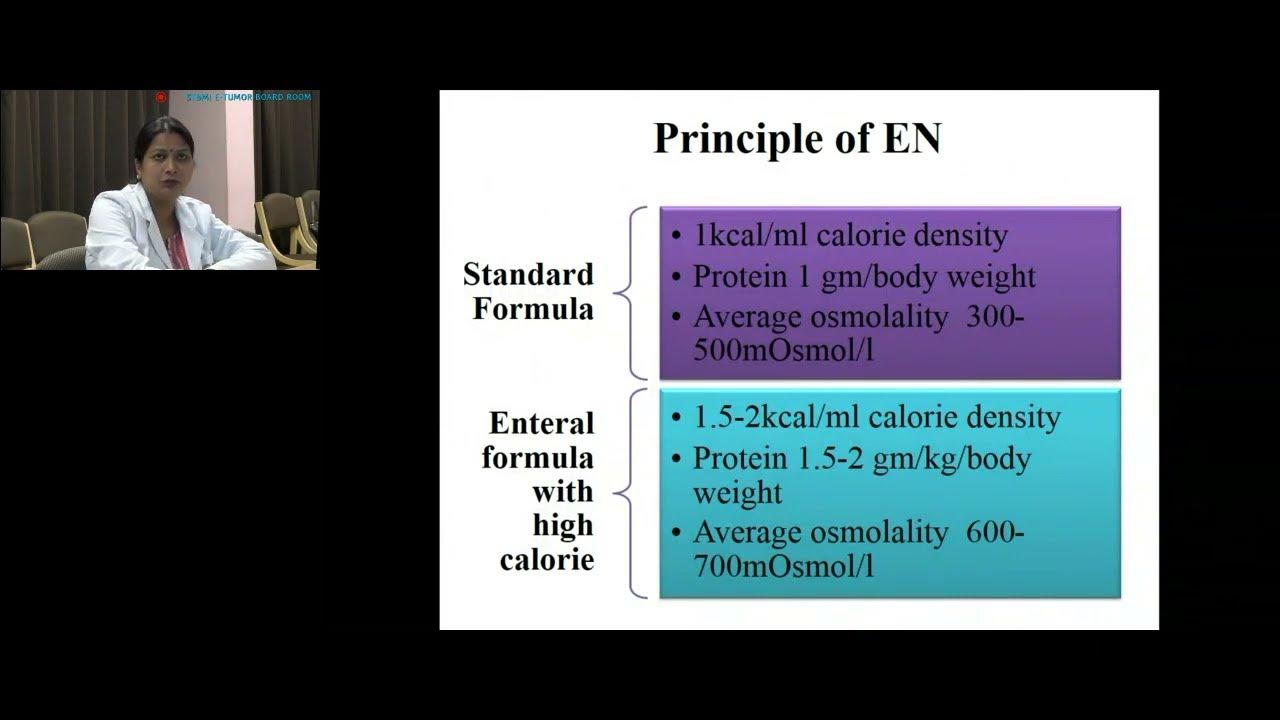Tube Feeding Methods (Continuous, Cyclic, Intermittent, Bolus)
Summary
TLDRThis video provides a comprehensive overview of the four feeding methods for enteral nutrition: continuous, cyclic, intermittent, and bolus. It explains how each method works, their advantages, and disadvantages. Continuous feeding is ideal for monitoring tolerance but can limit mobility, while cyclic feeding allows more daytime activity. Intermittent and bolus methods mimic normal eating patterns but require higher maintenance and tolerance to large volumes. The video also discusses the use of mechanical pumps and gravity drip methods for these feeding techniques, emphasizing their applications in different clinical settings.
Takeaways
- 📖 Enteral nutrition has four main feeding methods: continuous, cyclic, intermittent, and bolus.
- 🕒 Continuous feeding is most common in hospitals and involves delivering nutrition 24 hours a day.
- 💡 Mechanical feeding pumps or gravity drips can be used to deliver the formula during continuous feeding.
- 👍 Continuous feeding is beneficial for patients at high risk of aspiration or with gastroparesis.
- 😕 Continuous feeding can be inconvenient for active patients and may cause a persistent feeling of fullness.
- 🌙 Cyclic feeding occurs for less than 24 hours, commonly used during nocturnal feeding to allow for more mobility.
- 📈 Cyclic feeding can require a higher rate of infusion, which may be difficult for patients with gastrointestinal issues.
- ⏱ Intermittent feeding delivers nutrition for 20-60 minutes several times a day, closely mimicking normal eating patterns.
- 💪 Bolus feeding is the quickest method (less than 10 minutes per session), offering high mobility, but requires the patient to tolerate large volumes.
- 🧑⚕️ Both intermittent and bolus methods are high-maintenance for nursing staff as they require frequent monitoring and adjustments.
Q & A
What is enteral nutrition?
-Enteral nutrition refers to the delivery of nutrients directly into the gastrointestinal (GI) tract, typically through a feeding tube, for patients who cannot eat or swallow normally.
What are the four feeding methods used in enteral nutrition?
-The four feeding methods are continuous, cyclic, intermittent, and bolus.
What is continuous enteral feeding, and when is it commonly used?
-Continuous enteral feeding involves delivering formula over 24 hours via a feeding pump or gravity drip. It is commonly used in acute care settings to ensure steady and gradual nutrition, especially for patients at high risk of complications.
What are the advantages of continuous feeding?
-Advantages include easier tolerance at initiation, especially for patients at risk for aspiration or those who haven't eaten in a while. It's also beneficial for patients with gastroparesis and is low maintenance for nursing staff.
What are the disadvantages of continuous feeding?
-Disadvantages include inconvenience for active or mobile patients and a persistent feeling of fullness, which can reduce appetite and enjoyment of food, affecting quality of life.
What is cyclic enteral feeding, and how does it differ from continuous feeding?
-Cyclic feeding is delivered over a period less than 24 hours, commonly during the night (nocturnal feeding). Unlike continuous feeding, it allows patients to be more mobile during the day.
What are the advantages and disadvantages of cyclic feeding?
-Advantages include enhanced daytime mobility and avoidance of fullness before meals. Disadvantages include the need for a higher feeding rate, which can be difficult for some patients to tolerate, and the inconvenience of having to sleep with the head of the bed elevated.
What is intermittent enteral feeding, and how does it resemble a normal eating pattern?
-Intermittent feeding involves delivering formula over 20-60 minutes, three to six times a day, mimicking regular meal times. It allows breaks between feedings, giving patients more flexibility.
What are the advantages and disadvantages of intermittent feeding?
-Advantages include avoiding overnight feeding, which improves patient comfort, especially for those who prefer to sleep lying flat. Disadvantages include the need to tolerate large volumes of formula, which may be difficult for some patients, and higher maintenance for nursing staff.
What is bolus feeding, and how is it administered?
-Bolus feeding involves delivering a formula in under 10 minutes, three to six times per day, typically using a catheter tip syringe rather than a pump. It closely mimics normal eating patterns.
What are the key advantages and disadvantages of bolus feeding?
-Advantages include allowing for high mobility and avoiding overnight feeding. Disadvantages are similar to intermittent feeding, requiring the patient to tolerate large formula volumes and being more time-consuming for nursing staff.
Outlines

Cette section est réservée aux utilisateurs payants. Améliorez votre compte pour accéder à cette section.
Améliorer maintenantMindmap

Cette section est réservée aux utilisateurs payants. Améliorez votre compte pour accéder à cette section.
Améliorer maintenantKeywords

Cette section est réservée aux utilisateurs payants. Améliorez votre compte pour accéder à cette section.
Améliorer maintenantHighlights

Cette section est réservée aux utilisateurs payants. Améliorez votre compte pour accéder à cette section.
Améliorer maintenantTranscripts

Cette section est réservée aux utilisateurs payants. Améliorez votre compte pour accéder à cette section.
Améliorer maintenant5.0 / 5 (0 votes)






